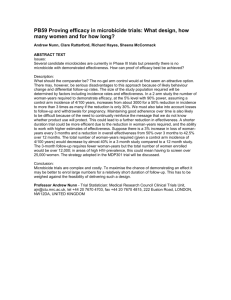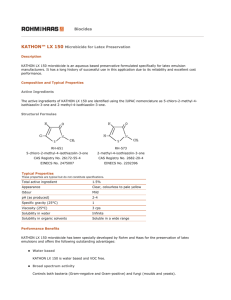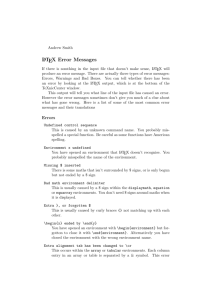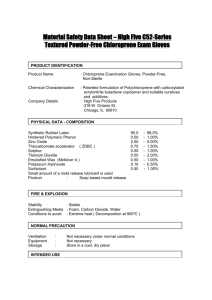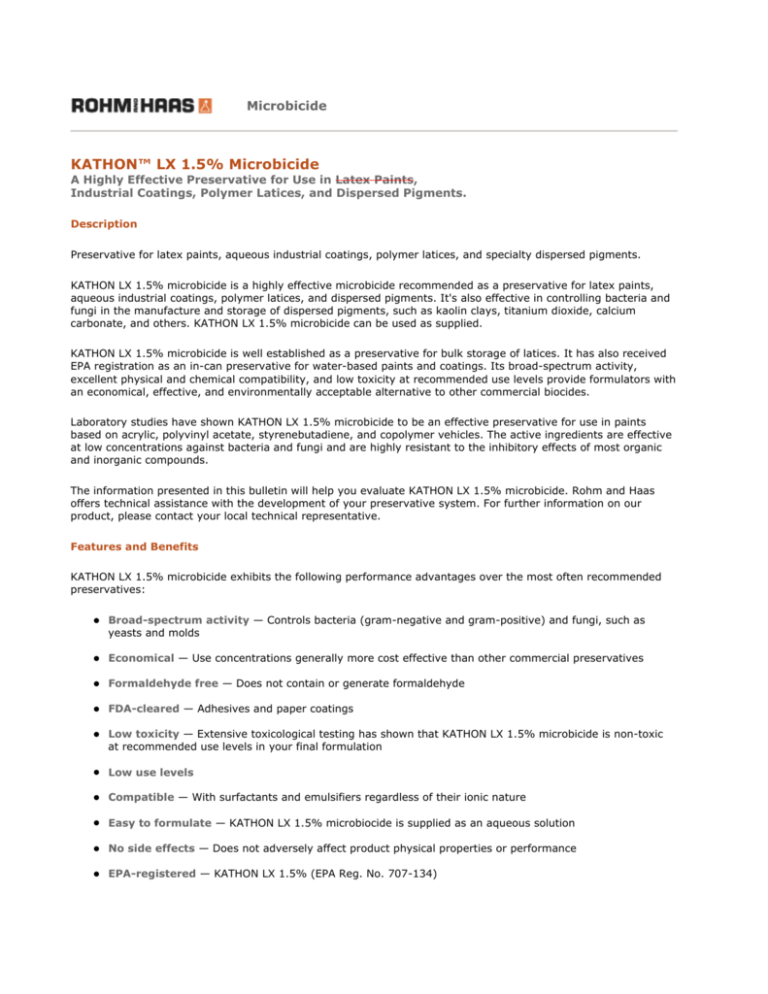
Microbicide
KATHON™ LX 1.5% Microbicide
A Highly Effective Preservative for Use in Latex Paints,
Industrial Coatings, Polymer Latices, and Dispersed Pigments.
Description
Preservative for latex paints, aqueous industrial coatings, polymer latices, and specialty dispersed pigments.
KATHON LX 1.5% microbicide is a highly effective microbicide recommended as a preservative for latex paints,
aqueous industrial coatings, polymer latices, and dispersed pigments. It's also effective in controlling bacteria and
fungi in the manufacture and storage of dispersed pigments, such as kaolin clays, titanium dioxide, calcium
carbonate, and others. KATHON LX 1.5% microbicide can be used as supplied.
KATHON LX 1.5% microbicide is well established as a preservative for bulk storage of latices. It has also received
EPA registration as an in-can preservative for water-based paints and coatings. Its broad-spectrum activity,
excellent physical and chemical compatibility, and low toxicity at recommended use levels provide formulators with
an economical, effective, and environmentally acceptable alternative to other commercial biocides.
Laboratory studies have shown KATHON LX 1.5% microbicide to be an effective preservative for use in paints
based on acrylic, polyvinyl acetate, styrenebutadiene, and copolymer vehicles. The active ingredients are effective
at low concentrations against bacteria and fungi and are highly resistant to the inhibitory effects of most organic
and inorganic compounds.
The information presented in this bulletin will help you evaluate KATHON LX 1.5% microbicide. Rohm and Haas
offers technical assistance with the development of your preservative system. For further information on our
product, please contact your local technical representative.
Features and Benefits
KATHON LX 1.5% microbicide exhibits the following performance advantages over the most often recommended
preservatives:
z Broad-spectrum activity — Controls bacteria (gram-negative and gram-positive) and fungi, such as
yeasts and molds
z Economical — Use concentrations generally more cost effective than other commercial preservatives
z Formaldehyde free — Does not contain or generate formaldehyde
z FDA-cleared — Adhesives and paper coatings
z Low toxicity — Extensive toxicological testing has shown that KATHON LX 1.5% microbicide is non-toxic
at recommended use levels in your final formulation
z Low use levels
z Compatible — With surfactants and emulsifiers regardless of their ionic nature
z Easy to formulate — KATHON LX 1.5% microbiocide is supplied as an aqueous solution
z No side effects — Does not adversely affect product physical properties or performance
z EPA-registered — KATHON LX 1.5% (EPA Reg. No. 707-134)
Typical Physical Properties
These properties are typical but do not constitute specifications.
Appearance
Pale yellow to green liquid
Odor
Mild, aromatic
Specific Gravity
1.02
Density, lbs./gal.
8.4
pH
3 to 5
Viscosity, cps at 25°C
3
Chemical Identification
The active ingredients are the compounds identified according to IUPAC nomenclature as 5-chloro-2-methyl-4isothiazolin-3-one and 2-methyl-4-isothiazolin-3-one.
Table 1: Chemical Composition of KATHON LX 1.5% Microbicide
Active Ingredients
5-Chloro-2-methyl-4-isothiazolin-3-one
1.15% min.
2-Methyl-4-isothiazolin-3-one
0.35% min.
Minimum Value
1.50%
Typical Value
1.50%
Inert Ingredients (Approximate Values)
Magnesium nitrate
3.0% max
Copper
0.15%
Organic impurities
—
Water
95.35%
Total Inert Ingredients
98.50%
Table 2: Minimum Inhibitory Concentration (MIC) of KATHON LX 1.5% Microbicide Against Bacteria
Test Bacterium
ATCC Number
Active Ingredients (ppm)
Bacillus cerus var.mycoides
RandH #L5
2
Bacillus subtilis
RandH #B2
2
6871
2
Gram-Positive
Brevibacterium ammoniagenes
Cellulomonas sp.
21339
6
Sarcina lutea
9341
5
Staphylococcus aureus
6538
2
155
2
Staphylococcus epidermidis
Streptococcus pyogenes
Streptomyces albus
624
9
3004
1
4335
2
Gram-Negative
Achromobacter parvulus
Alcaligenes faecalis
8750
2
12837
5
3906
5
11229
8
958
9
Nitrobacter agilis
14123
0.1
Nitrosomonas europea
19718
0.1
Azotobacter vinelandii
Enterobacter aerogenes
Escherichia coli
Flavobacterium suaveolens
Proteus vulgaris
8427
5
Pseudomonas aeruginosa
15442
5
Pseudomonas fluorescens
13525
2
Pseudomonas oleoverans
8062
5
Salmonella typhosa
6539
5
Shigella sonnei
9290
2
Chemical Properties
Miscibility
Miscible with water, methanol, ethanol, isopropyl alcohol, and acetic acid. Immiscible with acetone.
Compatibility
Biologically and physically compatible with anionic, nonionic, and cationic surfactants, halogens at use dilutions,
and most organic and inorganic compounds normally used in coatings, latices, and pigment slurries.
Stability
Stable as supplied at least one year at ambient temperatures.
Microbistatic Properties
The data in this bulletin were obtained with KATHON LX 1.5% microbicide as supplied or with a technical grade of
the active ingredients used as an intermediate in its manufacture.
Tables 2 and 3 list the minimum concentration in ppm of isothiazolones or KATHON LX 1.5% microbicide active
ingredient, which inhibits the growth of various microorganisms in test tube cultures. The data are intended to
indicate the activity of KATHON LX 1.5% microbicide in aqueous solutions and do not represent a claim for
recommended use concentrations nor list microorganisms necessarily involved in the contamination and
deterioration of paint and industrial coating systems.
Table 3: Minimum Inhibitory Concentration (MIC) of KATHON LX 1.5% Microbicide Against Fungi
Test Fungus
ATCC Number
Active Ingredients (ppm)
Alternaria dianthicola
11782
3
Aspergillus foetidus
16878
8
9642
9
Aspergillus niger
Aspergillus oryzae
10196
5
Aureobasidium pullulans
9294
6
Candida albicans (yeast)
11651
5
6205
9
11274
5
Chaetomium globosum
Cladosporium resinae
Coniophora puteana
9351
8
(QM 7638)
9
Lentinus lepideus
12653
4
Lenzites trabea (Gleophylum trabeum)
11539
6
Gliocladium fimbriatum
Mucor rouxii
RandH #L5-83
5
Penicillium funiculosum
9644
5
Penicillium variabile (glaucum)
USDA
2
Phoma glomerata
6735
3
12569
2
9348
5
Phoma herbarum (pigmentivora)
Pullularia (Aureobasidium) pullulans
Rhizpus stolonifer
10404
5
Rhototorula rubra (yeast)
9449
2
Saccharomyces cerevisiae (yeast)
2601
2
Trichophyton mentagrophytes
(interdigitale)
9533
5
Efficacy of KATHON LX 1.5% Microbicide as a Preservative
Evaluation of Preservatives
Water-based industrial formulations are susceptible to spoilage caused by microbial growth. Uncontrolled growth
may affect the color, odor, viscosity, pH, and other properties of the formulation. Extremely heavy growth may
even result in gassing, coagulation or clumping and may necessitate filtration or disposal of the spoiled
formulation.
Microbicides are used to prevent or overcome microbial growth. Their efficacy can be evaluated by incubating
samples of infected material containing a microbicide for a period of 6 weeks with periodic reinoculations with
microbial cultures. Counts of colony-forming units per milliliter (CFU/ml) obtained by an agar plating method or a
standard streak test indicate the degree of control afforded by the biocide. This severe test procedure is intended
to represent a repeated insult situation where many sources of contamination may exist. Other test procedures are
available to assist you in your individual formulation testing.
General Testing Procedure
A cell suspension is made by mixing 19 cultures of bacteria, yeasts, and filamentous fungi isolated from
contaminated polymer latices or paints and two additional pseudomonad cultures. A sample of naturally
contaminated polymer latex or paint is used as a second inoculum. Fifty-gram aliquots of latex or formulation in
screw-capped bottles are treated with a designated level of KATHON LX 1.5% microbicide and inoculated at twoweek intervals with the cell suspension and/or inoculum to provide at least one million CFU/ml of sample and held
for 6 weeks. Microbial populations are determined biweekly prior to each reinoculation by means of a standard
Agar Streak Test. The rating scale used to describe microbial growth is presented below...
Rating Description
Rating
Colony-Forming
Units/ml (Bacteria)
0
<10
T
10 to 100
1+
100 to 1,000
2+
1,000 to 10,000
3+
10,000 to 100,000
4+
>100,000
F
Fungal Growth
Interpreting Test Results
When several preservatives protect a particular formulation equally well for the duration of a test, only a
cost/performance comparison gives the potential user direction in selecting the preservative of choice. It is
important to note that all of the preservative treatment levels in this bulletin are shown as ppm active ingredient
(AI) not as product supplied, unless otherwise noted. KATHON LX 1.5% microbicide is generally more cost
effective when compared to other commercial preservatives.
The following tables show the results of 6-week preservative testing in various latex formulations.
Preservation of Polymer Latex-Based Paints
Table 4 shows the results of preservation tests (6 weeks) on acrylic and polyvinyl acetate latex-based paints with
KATHON LX 1.5% microbicide. Microbicide levels of 10-20 ppm Al gave control. Excellent control is achieved for
both the acrylic and polyvinyl acetate paints.
Table 4: Preservation of Latex-Based Paints
Preservative
Level, ppm AI
Microbial Growth Ratinga
2 weeks
4 weeks
6 weeks
0
4+
4+
4+
10
0
0
0
20
0
0
0
0
4+
4+
4+
10
0
0
0
20
0
0
0
0
(F)
4+
4+
10
0
0
0
20
0
0
0
Acrylic Exterior Paint (pH 9)
None
KATHON LX 1.5%
Acrylic Interior Paint (pH 8)
None
KATHON LX 1.5%
Polyvinyl Acetate Paint (pH 7.7)
None
KATHON LX 1.5%
aSee Rating Description
Table 5: Preservation of Acrylic Latices
Preservative
Level, ppm AI
Microbial Growth Ratinga
2 weeks
4 weeks
6 weeks
0
4+
4+
4+
25
0
0
0
40
0
0
0
0
0
2+
4+
20
0
0
0
40
0
0
0
Alkaline Latex (pH 9)
None
KATHON LX 1.5%
Acid Latex (pH 6)
None
KATHON LX 1.5%
aSee Rating Description
Table 6: Preservation of Polyvinyl Acetate Latices
Preservative
Microbial Growth Ratinga
Level, ppm AI
2 weeks
4 weeks
6 weeks
8 weeks
0
4+
4+
4+
4+
15
0
0
0
0
25
0
0
0
0
40
0
0
0
0
Acidic Latex (pH 5)
None
KATHON LX 1.5%
Neutral Latex (pH 7)
None
KATHON LX 1.5%
aSee Rating Description
0
0
2+
4+
4+
15
0
0
0
0
25
0
0
0
0
40
0
0
0
0
Preservation of Latex Emulsions
Preservation of Acrylic Latices
Table 5 gives the results of preservative tests on two acrylic polymer latices at different pH containing KATHON LX
1.5% microbicide. Trypticase soy broth was added to the acid latex (0.3% based on latex) after four weeks to
increase the growth rate. All levels of KATHON LX 1.5% microbicide were effective in controlling growth.
Preservation of Polyvinyl Acetate Latices
Table 6 presents the results of preservative tests on two polyvinyl acetate latices at pH 5 and 7 containing
KATHON LX 1.5% microbicide. KATHON LX 1.5% microbicide provided complete protection at 15-40 ppm AI in
both latices.
Eradication of Microbial Growth in Field-Contaminated Latices
KATHON LX 1.5% microbicide is very effective in cleaning up contamination and eradicating microbial growth in
field-contaminated polymer latices or paints. One such latex was treated with 30 ppm Al of KATHON LX 1.5%
microbicide and the microbial populations were measured after 4 and 7 days. Table 7 shows the results of this
study, which clearly demonstrate increased levels of contamination for the control latex and complete control for
the KATHON LX 1.5% microbicide-treated latex.
The enzymes generated by microbes cause the deterioration of organic components in latex formulations. It is
therefore essential to stop the secretion or production of these enzymes by the existing organisms as quickly as
possible. Studies show that KATHON LX 1.5% microbicide prevents secretion of additional enzymes by the
organisms immediately. Complete death of the organism may take longer to occur, however, the production of
enzymes ceases within 10 minutes after the addition of KATHON LX 1.5% microbicide.
Preservation of Dispersed Pigments
Table 8 gives the results of preservative tests on three levels of KATHON LX 1.5% microbicide in a TiO2 slurry.
Excellent preservation is obtained at all levels tested. KATHON LX 1.5% microbicide also performs well in other
dispersed pigments such as kaolin clays and calcium carbonate.
Table 7: Eradication of Microbial Growth in Contaminated Acrylic Latex (pH 9-9.5)
Preservative
None
KATHON LX 1.5%
Level, ppm AI
Microbial Population
Colony-Forming Units/mla
0 days
4 days
7 days
0
3+
4+
4+
30
—
0
0
aSee Rating Description
Table 8: Preservation of TIO2 Slurry (pH 7.8)
Preservative
None
KATHON LX 1.5%
aSee Rating Description
Level, ppm AI
Microbial Population
Colony-Forming Units/mla
2 weeks
4 weeks
6 weeks
0
4+
4+
4+
10
0
0
0
20
0
0
0
30
0
0
0
Directions for Use
KATHON LX 1.5% microbicide is supplied as a liquid which can be readily incorporated during paint formulation.
Studies have shown that point of addition of KATHON LX 1.5% microbicide does not adversely affect paint
performance. KATHON LX 1.5% microbicide may be added directly into the grind or letdown and is usually added
as the last ingredient in either stage.
The actual required concentration of preservative depends on the particular latex, the expected frequency of
repeated microbial contamination, and the necessary level of protection. To insure uniform distribution of
preservative, treat the latex or paint while using adequate agitation.
Use Level
Refer to Table 9.
Paints and Coatings
Treat 1000 lbs. of material with 0.43 to 1.65 lbs. of KATHON LX 1.5% microbicide to provide a level of 6.25 to 25
ppm active isothiazolones.
Polymer Latices
Treat 1000 lbs. latex with 0.43 to 3.3 lbs. of KATHON LX 1.5% microbicide to provide a level of 6.25 to 50 ppm
active isothiazolones.
Table 9: KATHON LX 1.5% Microbicide Conversion Chart
Parts per
Million (ppm)
Active Isothiazolones
Pounds of
KATHON LX 1.5%
per 1000 Pounds of Paint
6.25
.43
10.00
.67
15.00
1.00
20.00
1.33
25.00
1.65
30.00
2.00
40.00
2.66
50.00
3.30
Handling Precautions
Do not get in eyes, on skin or clothing. Wear goggles and rubber gloves when handling. Avoid breathing vapor or
mist. Do not take internally. Wash thoroughly after handling.
First Aid Measures
After contact with eyes: FLUSH IMMEDIATELY with plenty of water with the eyes held open for at least 15 minutes.
Get prompt medical attention.
After contact with skin: FLUSH IMMEDIATELY with plenty of water for at least 15 minutes. Shower with soap and
water. Launder contaminated clothing before reuse.
If swallowed and victim is conscious: Dilute by giving two glasses of water to drink and call a physician. Never give
anything by mouth to an unconscious person.
Chemical Spill Clean-Up Procedures
The active ingredient of KATHON LX 1.5% microbicide is readily deactivated or neutralized to nontoxic components
by the addition of a freshly prepared solution of 5% sodium bicarbonate and 5% sodium hypochlorate in water.
Apply solution at a ratio of 10 times deactivation solution per estimated volume or residual spill.
Personnel cleaning up spills should wear protective clothing consisting of splash goggles, face shields, plastic rain
jackets and pants, butyl rubber boots, and impervious gloves. All protective equipment for spill cleanup should be
thoroughly deactivated and cleaned before reuse.
To Handle a Spill
1.
Absorb as much of the spilled liquid KATHON LX 1.5% microbicide as possible using an inert absorbent
material such as sand, diatomaceous earth, or kitty litter.
2.
Place the absorbed material and the absorbent into a container such as a drum that has been lined with a
polyethylene liner. The contaminated absorbent material may be deactivated when the immediate
emergency of handling the spill has been resolved.
3.
Use a freshly prepared solution of 5% sodium bicarbonate and 5% sodium hypochlorite in water to
deactivate the remaining KATHON LX 1.5% microbicide that could not be absorbed. Use a volume ratio of
20 parts decontaminant to one part of active microbicide.
4.
Allow the decontamination solution to remain in contact with the KATHON LX 1.5% microbicide for up to 30
minutes. The actual decontamination reaction takes place in much less time, but the added time ensures
that the reaction goes to completion.
5.
Once the decontamination reaction has taken place, the resultant decontaminated material may be safely
flushed from the area using a fire hose and large amounts of water.
6.
Once the spill areas have been cleaned up, the absorbed material may be decontaminated. Place the
decontamination solution in the drum to thoroughly wet the solid material. Let the container stand open for
48 hours to avoid the buildup of pressure from the decontamination reaction, then seal and dispose of it,
according to appropriate local, state, and federal regulations.
Instructions on preparing decontamination solutions are presented in the following table.
Table 10: Toxicity of KATHON LX 1.5% Microbicide (As Supplied)
Acute oral (LD50) – rats
3700 mg/kg
Acute dermal (LD50)
– rabbits (females)
3600 mg/kg
– rabbits (males)
3500 mg/kg
Skin irritation – rabbit
Severe
Eye irritation – rabbit
Severe
Skin sensitization* – guinea pigs
*Based on aqueous solutions of the active ingredient.
Sensitizer
Table 11: Preparation of Decontamination Solution (10 Pounds)
pH (Final Solution)
4.0
4.0
4.0-5.0
Sodium Sulfite
Sodium Bisulfite
Sodium Metabisulfite
Na2SO3
NaHSO3
Na2S2O3
Decontamination agent
1.2
1.0
0.9
Water
7.9
9.0
9.1
Hydrochloric acid, 37%
0.9
—
—
10.0
10.0
10.0
Ingredient (lb)
TOTAL
NOTE: Decontamination solution must have pH on the acid side, since it is much less effective when alkaline.
Table 12: FDA Clearances for KATHON LX 1.5% Microbicide
Country
Product
Regulatory Clearance
Application
USA
The active
ingredients in
KATHON LX 1.5%
Microbicide
FDA 21 CFR 175.105
(Adhesives)
For use only as an antimicrobial agent in polymer
latex emulsions
FDA 21 CFR 175.300
(Resinous and Polymeric
Coatings)
For use only as an antimicrobial agent in emulsionbased silicon coatings at a level not to exceed 50
mg active ingredient/Kg in the coating formulation
FDA 21 CFR 175.320
(Resinous and Polymeric
Coatings for Polyolefin
films)
For use only as an antimocrobial agent in emulsionbased silicon coatings at a level not to exceed 50
mg active ingredient/Kg in the coating formulation
FDA 21 CFR 176.170
(Components of paper
and paperboard in contact
with aqueous and fatty
foods)
1. As an antimicrobial agent for finished coatings
and for additives used in the manufacture of
paper and and paperboard including fillers,
binders, pigment slurries, and sizing solutions
not exceeding 25 ppm active ingredient in
coating formulations and additives
2. As an antimicrobial agent for polymer latex
emulsions in paper coatings not exceeding 50
ppm active ingredient in the coating formulation
FDA 21 CFR 176.180
(Components of paper
and paperboard in contact
with dry foods)
1. As an antimicrobial agent for finished coatings
and for additives used in the manufacture of
paper and paperboard including fillers, binders,
pigment slurries, and sizing solutions not
exceeding 25 ppm active ingredient in coating
formulations and additives
2. As an antimicrobial agent for polymer latex
emulsions in paper coatings not exceeding 50
ppm active ingredient in the coating formulation
These clearances apply only to KATHON LX 1.5% Microbicide as submitted by Rohm and Haas Company. Formulations containing other
ingredients may need to be resubmitted for approval.
Material Safety Data Sheets
Rohm and Haas Company maintains Material Safety Data Sheet (MSDS) on all of its products. These contain
important information that you may need to protect your employees and customers against any known health and
safety hazards associated with our products.
We recommend you obtain copies of MSDS for our products from your local Rohm and Haas technical
representative. In addition, we recommend you obtain copies of MSDS from your suppliers of other raw materials
used with our products.
KATHON is a trademark of Rohm and Haas Company or of its subsidiaries or affiliates. It is intended to designate goods marketed in North
and South America; the same goods may be marketed in other countries, generally under other company trademark designations.
These suggestions and data are based on information we believe to be reliable. They are offered in good faith, but without guarantee, as
conditions and methods of use of our products are beyond our control. We recommend that the prospective user determine the suitability of
our materials and suggestions before adopting them on a commercial scale.
Suggestions for uses of our products or the inclusion of descriptive material from patents and the citation of specific patents in this
publication should not be understood as recommending the use of our products in violation of any patent or as permission or license to use
any patents of the Rohm and Haas Company.
©Rohm and Haas, 2007
All rights reserved.
July 2007
CS-549B


